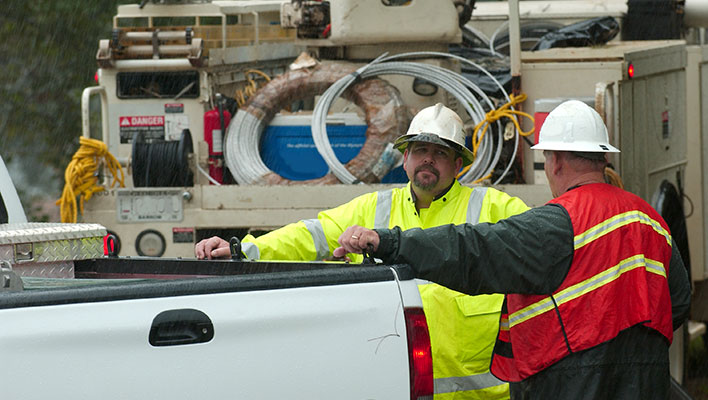Chris McClain is engineering supervisor at Southern Company and is an advocate for helping the electric transmission and distribution industry advance power restoration by leveraging technology to seamlessly manage damage assessment and repair. Bringing insights from the front lines of digital utility transformation, his blog series walks readers through the journey from managing mountains of paper feeder maps to mobile workforce management and power restoration in one of the country’s frequent storm hotspots.
Simply put, mobile workforce management is the set of processes and technologies deployed across enterprises to support and empower mobile workers as they perform their jobs. It’s a widely used tool in the electric utility industry, specifically in transmission and distribution power delivery functions. Whether you’re talking about field reps providing daily service to customers, engineers/designers taking field notes and staking jobs, crews performing line work, or the routine maintenance of aging infrastructure, mobile workforce management is playing an ever-increasing role.
Mobile Workforce Management will be even more critical going forward, especially for getting the lights back on as safely and efficiently as possible following severe weather events. As a strategy to gain efficiencies around storm restoration, mutual assistance agreements and best-practices sharing have become focal points of our industry in recent years. In this spirit, I want to share my personal journey in the pursuit of a mobile workforce digital transformation, hopefully providing a few best-practices and lessons learned to aid in your own journey.
In my last blog, I argued that going digital and eliminating the mountain of paper feeder maps isn’t the entire solution to mobile workforce management during a storm response. Organizations need to address a wider variety of components in their mobile workforce management strategy, including secure access to GIS data, integration of outage management, and connecting the field and back office for a shared view of damage assessment and repair. My advice: start small and scale big.
As I learned firsthand, solutions can’t be overly complicated. Prior to the true tablet evolution, we attempted to leverage “tablet PC’s” (basically, laptops with screens that folded all the way back and came with a stylus) in an attempt to give field personnel a mobile computing device from which to work. These were so cumbersome, employees often left them in the vehicle, opting for traditional methods of handwritten field notes followed by desk-based computer work with a keyboard and mouse. We also mounted ruggedized laptops in vehicles of certain employees and, while that has persisted for some workgroups, it’s often limited to ticket-based work assignments and rarely are those devices taken from the vehicle and toted around.
Our next effort was a trial of first-generation iPads. The clear argument against such devices was that we have legacy Windows applications. For us, this became a moot point because field workers weren’t leveraging our legacy systems while standing in the field anyway. They were coming back to the office for that. That said, the benefits of iPads are many:
- True mobile devices: always on (no “bootup” time), easy to carry, true touchscreen mobile interface
- Inexpensive: especially compared to rugged laptops
- Durable: more so than one would expect with a rugged case (which are also relatively inexpensive)
- Built-in LTE: always connected, no dealing with Wi-Fi-only or tethering
- Built-in GPS: great for navigation to assets and for leveraging location-based apps
- 3rd-Party Apps: iOS app store has a seemingly endless supply of third-party apps for all types of needs
- Web Apps: increasingly popular, device agnostic, browser-based apps reduce the downside of native apps
- Screen size: larger screen real-estate than a phone for map-viewing, etc.
- Can double as a laptop: with keyboard, mouse, and virtual Windows desktop
When we gave iPads to a group of linemen and the engineering staff they work with, they discovered too many benefits to ignore. In addition to the items listed above, we were able to do some amazing things:
- Document conversion: we converted all our construction standards, spec books, safety manuals, etc. to PDF documents, reducing the binders upon binders of printed documents that had to be stored and updated on every truck across the system. They are now always available, up-to-date, and searchable.
- Paperless processes: construction drawings, work estimates, material lists, time sheets, etc. could all be loaded to a SharePoint site and accessed from tablets. PDF design drawings could be easily marked up and forms could be easily filled out with off-the-shelf PDF editing apps.
- Document transmission: completed work could be saved back to SharePoint, uploaded elsewhere, or emailed to the necessary individual(s).
We quickly found more ways to utilize the devices by simply making data accessible to them: GIS mapping info, asset/equipment historical data and operations manuals, customer reliability info, meter demand info, customer outage info, various reports and dashboards, etc. These quick and easy wins gave our field personnel information at their fingertips, allowing them to work more safely and efficiently, and provide better customer service. Perhaps most importantly, it was a grassroots effort that led to broader adoption AND created an appetite within the field workforce for pursuing even more mobile opportunities.
On the other hand, we were left with a challenge: We needed to manage the development of a mobile workforce management strategy that eliminated the app overload for linemen, brought systems and people together in concert and context, and maintained the security of proprietary information. Importantly, integrating our mature GIS capabilities (and significant investment) would be critical to the strategy.
According to technology research firm, IDC, “by 2025, 50% of utilities will implement a platform approach to operations integrating core applications, improving visibility, management, and efficiency to boost tight operating margins.” In my opinion, we need to strive for mobile workforce management solutions that indeed integrate and leverage a power provider’s storm response digital ecosystem (e.g., GIS, OMS, WMS). In my next blog, I’ll explore different pathways to integration and real-time situational awareness.
I hope you are finding these blogs valuable as you consider your own digital transformation, and I welcome your insights and questions as the series continues.
Did you enjoy Chris’s blog? Check out his previous post: 5 Keys to Advance Power Restoration: Eliminating the Paper Data Problem




